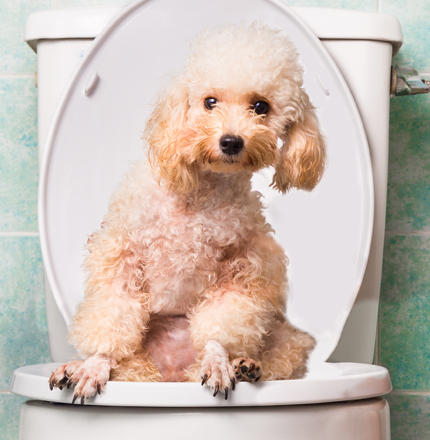Significant Issues Regarding Flushing Animal Waste Down the Toilet
Significant Issues Regarding Flushing Animal Waste Down the Toilet
Blog Article
We have come across this post relating to Can You Flush Dog and Cat Poo Down the Toilet? below on the internet and concluded it made good sense to share it with you over here.

When it involves throwing away waste, specifically animal waste, many people frequently resort to the practical alternative of flushing it down the commode. Nonetheless, this apparently very easy remedy can have serious consequences for the setting and public health. In this post, we'll check out why flushing animal waste down the bathroom is a bad idea and give different approaches for appropriate disposal.
Introduction
Correct waste disposal is essential for keeping ecological sustainability and public health. While it may seem harmless to purge animal waste down the toilet, it can result in numerous issues, both for the environment and human well-being.
Dangers of flushing pet waste
Ecological influence
Flushing animal waste introduces unsafe bacteria and pathogens into waterways, which can adversely influence aquatic communities. These microorganisms can pollute water resources and damage marine life, interrupting delicate environments.
Public health issues
Animal waste has harmful microorganisms such as E. coli and Salmonella, which can posture significant health risks to humans. Flushing pet waste down the bathroom can pollute water products, causing the spread of diseases and infections.
Alternatives to flushing
Instead of flushing animal waste down the toilet, there are a number of alternate disposal methods that are more eco-friendly and sanitary.
Composting
Composting animal waste is a green means to take care of it. By composting, raw material is broken down into nutrient-rich dirt, which can be used to feed yards and plants.
Landfill disposal
Dealing with pet waste in a landfill is one more option. While not as eco-friendly as composting, it is a more secure alternative to flushing, as it avoids the contamination of water resources.
Pet garbage disposal systems
There are specific family pet waste disposal systems available that securely and hygienically dispose of animal waste. These systems frequently use enzymes to break down waste and get rid of odors.
Steps to correct animal waste disposal
To make sure proper disposal of pet waste, comply with these steps:
Scooping and landing waste
Consistently scoop and bag animal waste utilizing naturally degradable bags. This avoids waste from contaminating the setting.
Utilizing assigned waste bins
Dispose of bagged animal waste in assigned waste containers, such as compost bins or landfill containers. Avoid flushing it down the bathroom in any way prices.
Cleansing litter boxes and family pet locations regularly
Regularly tidy can and pet dog areas to prevent the build-up of waste and germs. Usage pet-safe cleansing products to keep hygiene.
Advantages of appropriate disposal approaches
Taking on proper disposal approaches for animal waste uses numerous advantages:
Reduced environmental pollution
Appropriate disposal approaches decrease the threat of environmental pollution, protecting rivers and communities from contamination
Lessened threat of water contamination.
By avoiding flushing animal waste down the bathroom, here the threat of water contamination is significantly reduced, protecting public health.
Enhanced cleanliness and health
Correct disposal approaches advertise much better cleanliness and hygiene, producing a much safer atmosphere for both humans and animals.
Verdict
Finally, purging pet waste down the toilet is harmful to the setting and public health. By adopting different disposal techniques and adhering to appropriate waste management practices, we can reduce the adverse influence of pet waste and add to a cleaner, healthier earth.
What To Do With Dog Poo – The Do's And Don'ts Of Disposing Of Faeces
Dog poo bins
Some councils provide dedicated dog waste bins in popular dog-walking areas that can take dog poo that has been bagged but you can legally dispose of dog waste in any public litter bin, as long as it is securely bagged. This also applies to your wheelie bin at home.
Do not flush
Water companies do not recommend flushing dog faeces down the toilet because certain parasites can survive the water processing treatment and are potentially harmful to humans. You should also never consider flushing dog poo that has been bagged down the toilet as the bags will not break down and instead create severe blockages in the sewage system.
In the woods
The Forestry Commission promotes a ‘stick and flick’ method for dealing with waste in the woods. This means finding a stick and using it to flick any poo from off the path so that it is out of the way of other walkers. You could also bury it as long as it is not in an area where there might be livestock.
Livestock
Parasites found in dog poo can be transmitted to livestock if they inadvertently eat infected faeces that has been left on grazing land. This could result in the death of sheep or abortion in cattle so you should always make sure you pick up your dog’s waste in fields where livestock could be present.

Regularly tidy can and pet dog areas to prevent the build-up of waste and germs. Usage pet-safe cleansing products to keep hygiene.
Advantages of appropriate disposal approaches
Taking on proper disposal approaches for animal waste uses numerous advantages:
Reduced environmental pollution
Appropriate disposal approaches decrease the threat of environmental pollution, protecting rivers and communities from contamination
Lessened threat of water contamination.
By avoiding flushing animal waste down the bathroom, here the threat of water contamination is significantly reduced, protecting public health.
Enhanced cleanliness and health
Correct disposal approaches advertise much better cleanliness and hygiene, producing a much safer atmosphere for both humans and animals.
Verdict
Finally, purging pet waste down the toilet is harmful to the setting and public health. By adopting different disposal techniques and adhering to appropriate waste management practices, we can reduce the adverse influence of pet waste and add to a cleaner, healthier earth.
What To Do With Dog Poo – The Do's And Don'ts Of Disposing Of Faeces
Dog poo bins
Some councils provide dedicated dog waste bins in popular dog-walking areas that can take dog poo that has been bagged but you can legally dispose of dog waste in any public litter bin, as long as it is securely bagged. This also applies to your wheelie bin at home.
Do not flush
Water companies do not recommend flushing dog faeces down the toilet because certain parasites can survive the water processing treatment and are potentially harmful to humans. You should also never consider flushing dog poo that has been bagged down the toilet as the bags will not break down and instead create severe blockages in the sewage system.
In the woods
The Forestry Commission promotes a ‘stick and flick’ method for dealing with waste in the woods. This means finding a stick and using it to flick any poo from off the path so that it is out of the way of other walkers. You could also bury it as long as it is not in an area where there might be livestock.
Livestock
Parasites found in dog poo can be transmitted to livestock if they inadvertently eat infected faeces that has been left on grazing land. This could result in the death of sheep or abortion in cattle so you should always make sure you pick up your dog’s waste in fields where livestock could be present.

I'm very interested in 10 Things You Should Never Flush Down The Toilet and I hope you enjoyed the blog posting. Make sure you take a moment to distribute this blog if you liked it. Many thanks for your time. Kindly visit our site back soon.
Call Today Report this page